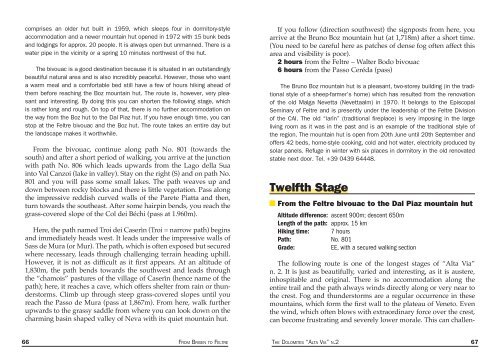You also want an ePaper? Increase the reach of your titles
YUMPU automatically turns print PDFs into web optimized ePapers that Google loves.
comprises an older hut built in 1959, which sleeps four in dormitory-style<br />
accommodation and a newer mountain hut opened in 1972 with 15 bunk beds<br />
and lodgings for approx. 20 people. It is always open but unmanned. There is a<br />
water pipe in the vicinity or a spring 10 minutes northwest of the hut.<br />
The bivouac is a good destination because it is situated in an outstandingly<br />
beautiful natural area and is also incredibly peaceful. However, those who want<br />
a warm meal and a comfortable bed still have a few of hours hiking ahead of<br />
them before reaching the Boz mountain hut. The route is, however, very pleasant<br />
and interesting. By doing this you can shorten the following stage, which<br />
is rather long and rough. On top of that, there is no further accommodation on<br />
the way from the Boz hut to the Dal Piaz hut. If you have enough time, you can<br />
stop at the Feltre bivouac and the Boz hut. The route takes an entire day but<br />
the landscape makes it worthwhile.<br />
From the bivouac, continue along path No. 801 (towards the<br />
south) and after a short period of walking, you arrive at the junction<br />
with path No. 806 which leads upwards from the Lago della Sua<br />
into Val Canzoi (lake in valley). Stay on the right (S) and on path No.<br />
801 and you will pass some small lakes. The path weaves up and<br />
down between rocky blocks and there is little vegetation. Pass along<br />
the impressive reddish curved walls of the Parete Piatta and then,<br />
turn towards the southeast. After some hairpin bends, you reach the<br />
grass-covered slope of the Col dei Béchi (pass at 1.960m).<br />
Here, the path named Troi dei Caserìn (Troi = narrow path) begins<br />
and immediately heads west. It leads under the impressive walls of<br />
Sass de Mura (or Mur). The path, which is often exposed but secured<br />
where necessary, leads through challenging terrain heading uphill.<br />
However, it is not as difficult as it first appears. At an altitude of<br />
1,830m, the path bends towards the southwest and leads through<br />
the “chamois” pastures of the village of Caserìn (hence name of the<br />
path); here, it reaches a cave, which offers shelter from rain or thunderstorms.<br />
Climb up through steep grass-covered slopes until you<br />
reach the Passo de Mura (pass at 1,867m). From here, walk further<br />
upwards to the grassy saddle from where you can look down on the<br />
charming basin shaped valley of Neva with its quiet mountain hut.<br />
If you follow (direction southwest) the signposts from here, you<br />
arrive at the Bruno Boz mountain hut (at 1,718m) after a short time.<br />
(You need to be careful here as patches of dense fog often affect this<br />
area and visibility is poor).<br />
2 hours from the Feltre – Walter Bodo bivouac<br />
6 hours from the Passo Ceréda (pass)<br />
The Bruno Boz mountain hut is a pleasant, two-storey building (in the traditional<br />
style of a sheep-farmer’s home) which has resulted from the renovation<br />
of the old Malga Nevetta (Nevettaalm) in 1970. It belongs to the Episcopal<br />
Seminary of Feltre and is presently under the leadership of the Feltre Division<br />
of the CAI. The old “larìn” (traditional fireplace) is very imposing in the large<br />
living room as it was in the past and is an example of the traditional style of<br />
the region. The mountain hut is open from 20th June until 20th September and<br />
offers 42 beds, home-style cooking, cold and hot water, electricity produced by<br />
solar panels. Refuge in winter with six places in dormitory in the old renovated<br />
stable next door. Tel. +39 0439 64448.<br />
Twelfth Stage<br />
From the Feltre bivouac to the Dal Piaz mountain hut<br />
Altitude difference: ascent 900m; descent 650m<br />
Length of the path: approx. 15 km<br />
Hiking time: 7 hours<br />
Path: No. 801<br />
Grade:<br />
EE, with a secured walking section<br />
The following route is one of the longest stages of “Alta Via”<br />
n. 2. It is just as beautifully, varied and interesting, as it is austere,<br />
inhospitable and original. There is no accommodation along the<br />
entire trail and the path always winds directly along or very near to<br />
the crest. Fog and thunderstorms are a regular occurrence in these<br />
mountains, which form the first wall to the plateau of Veneto. Even<br />
the wind, which often blows with extraordinary force over the crest,<br />
can become frustrating and severely lower morale. This can challen-<br />
66 FROM BRIXEN TO FELTRE THE DOLOMITES “ALTA VIA” N.2 67

















